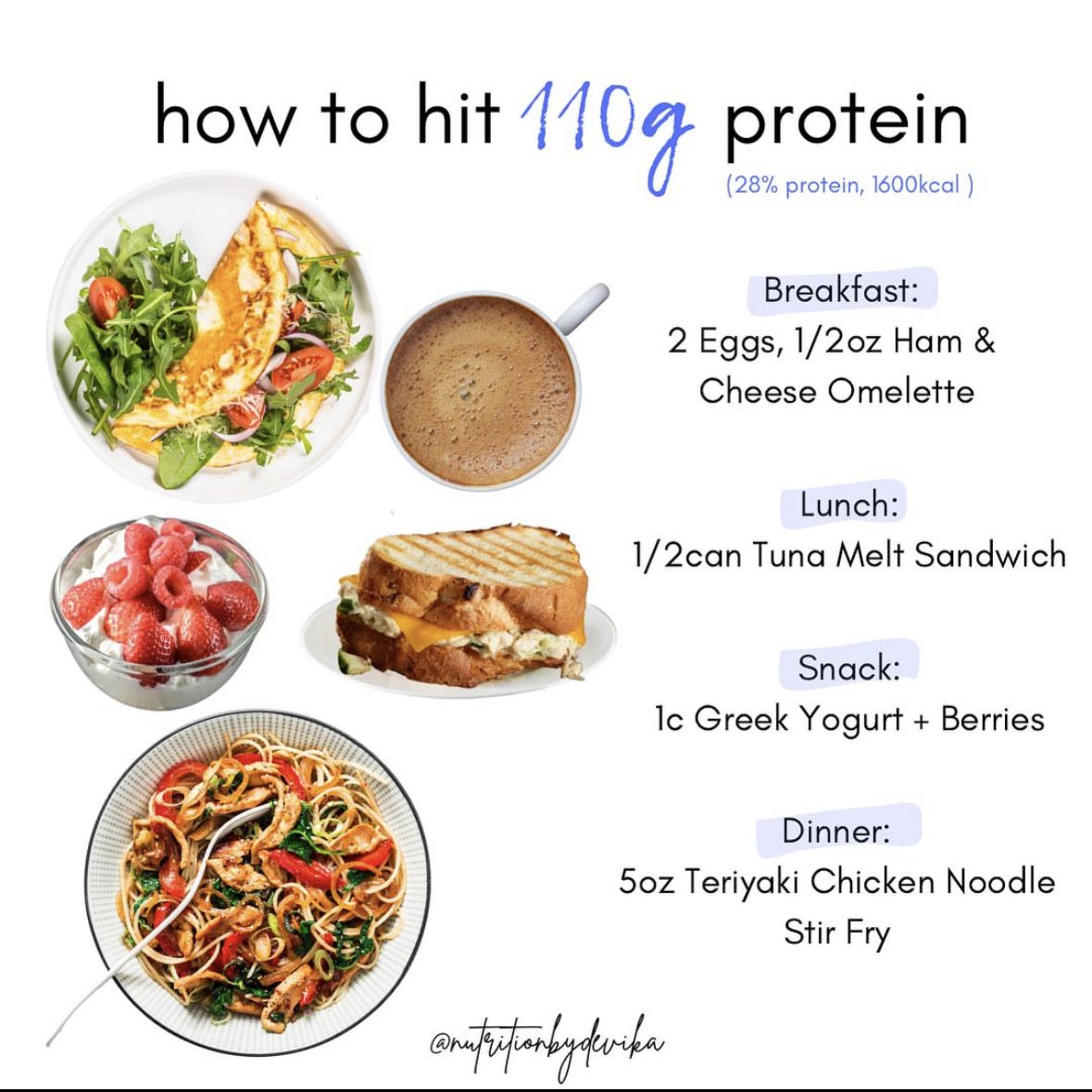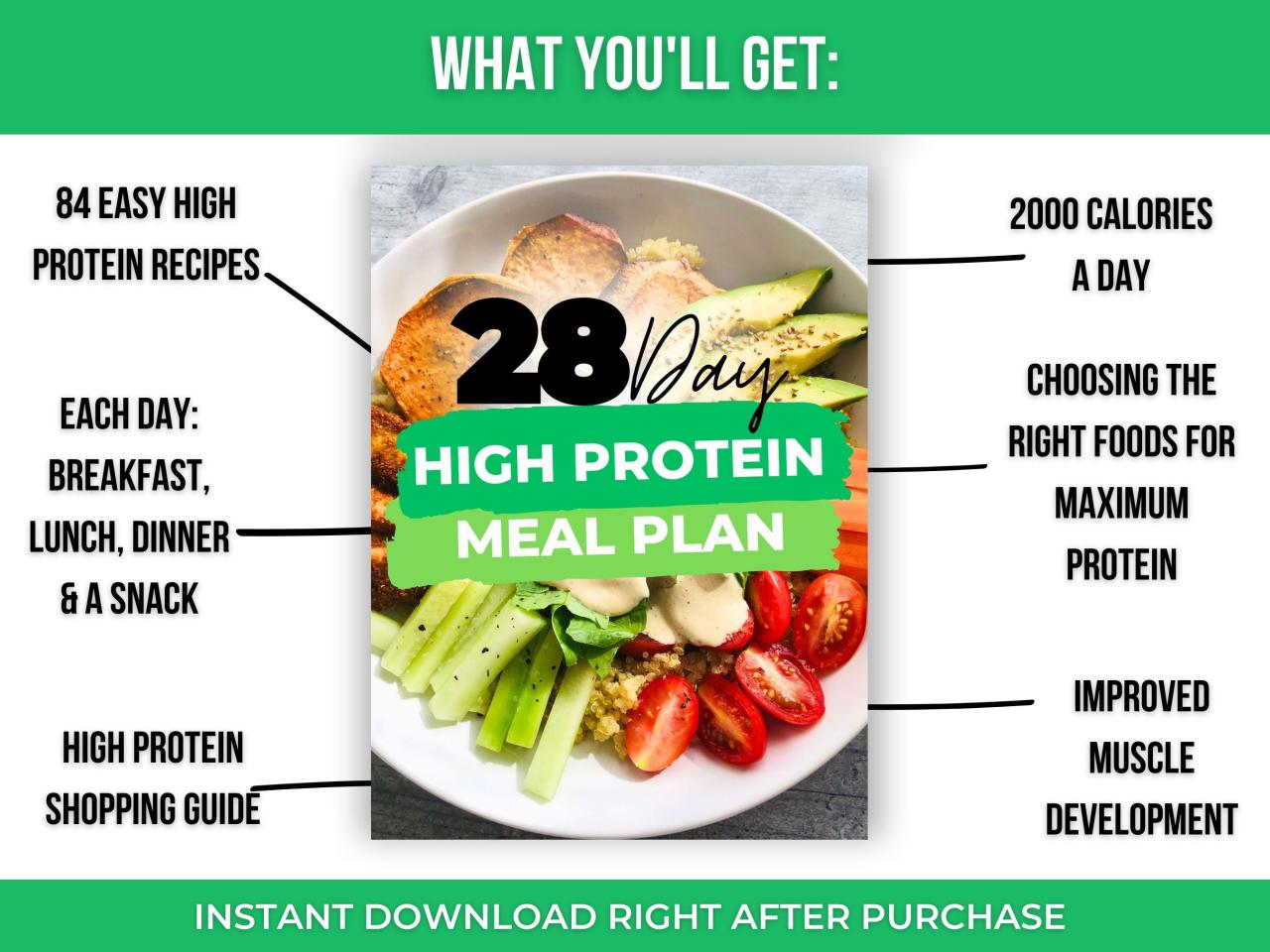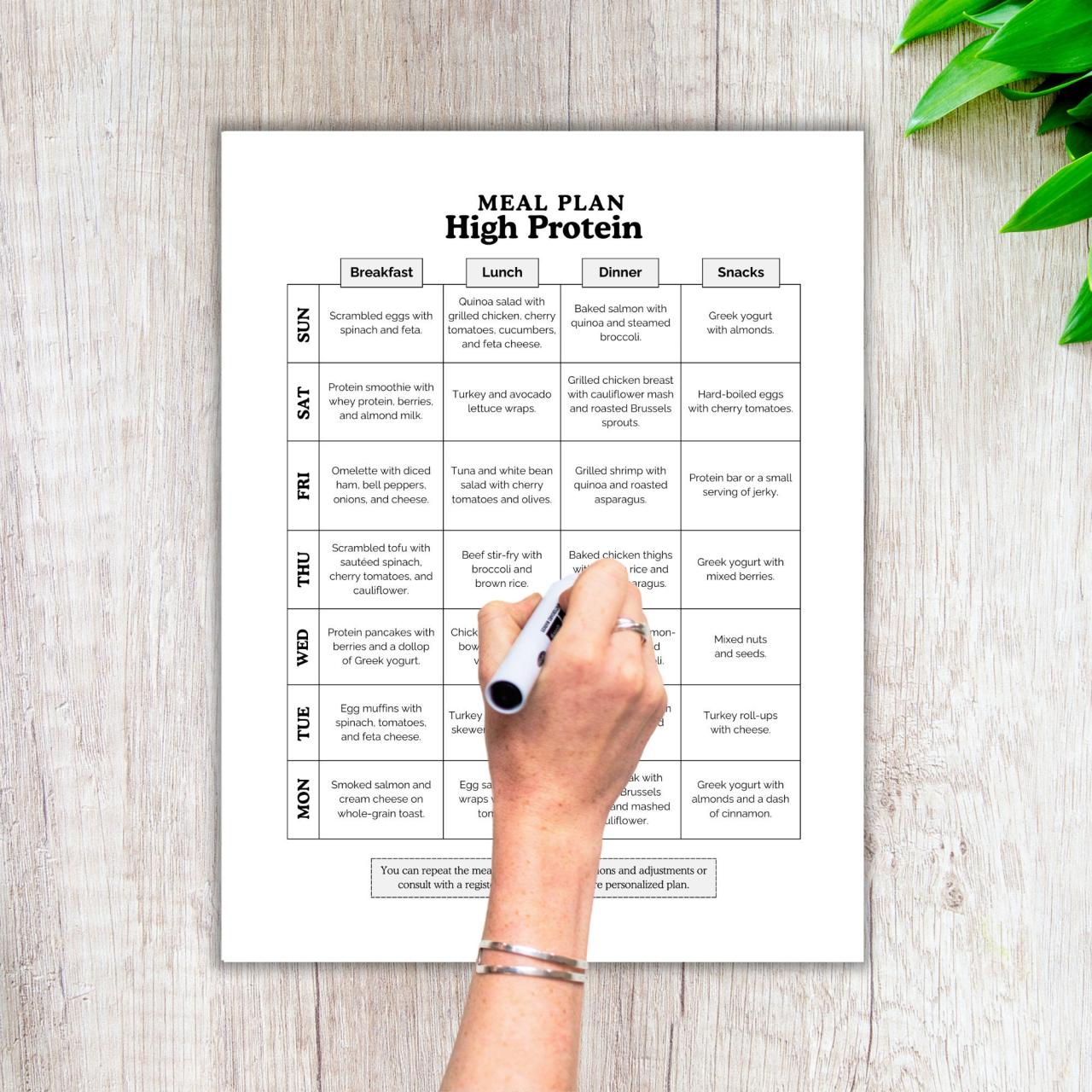Embark on a journey into the world of high-protein meal plans for active lifestyles, where nutritious choices meet the demands of your energetic routine. Discover how these meal plans can optimize your performance and enhance your well-being as you embrace a lifestyle full of vitality and vigor.
As we delve deeper, you'll uncover the essentials of crafting a high-protein meal plan tailored to your needs and preferences, ensuring you stay on track towards your health and fitness goals.
Introduction to High-Protein Meal Plans for Active Lifestyle

High-protein meal plans are designed to provide individuals with a diet that is rich in protein, which is essential for muscle growth, repair, and overall body function. These meal plans typically include a variety of protein sources to help individuals meet their daily protein needs.
For individuals with an active lifestyle, high-protein diets offer numerous benefits. Protein helps to repair and build muscle tissues, which is crucial for recovery after exercise and improving athletic performance. Additionally, protein helps to keep you feeling full and satisfied, which can aid in weight management and reduce cravings for unhealthy snacks.
Examples of Popular High-Protein Foods
- Chicken breast: A lean source of protein that is versatile and can be included in various dishes.
- Greek yogurt: Packed with protein and probiotics, making it a great option for a post-workout snack.
- Quinoa: A complete protein that is also high in fiber and essential nutrients.
- Eggs: An inexpensive and versatile protein source that can be enjoyed in many ways.
- Salmon: A fatty fish that is rich in omega-3 fatty acids and high-quality protein.
Designing a High-Protein Meal Plan
To create an effective high-protein meal plan for an active lifestyle, it is essential to consider the individual's protein requirements based on their activity levels and goals. Balancing macronutrients is also crucial to ensure optimal performance and recovery. Additionally, meal prepping and planning can help streamline the process and ensure consistency in nutrient intake.
Calculating Protein Requirements
When determining protein requirements, consider factors such as activity level, fitness goals, age, and weight. A general guideline is to consume 1.2-2.0 grams of protein per kilogram of body weight for active individuals. For example, a 150-pound person should aim for 82-136 grams of protein per day.
Importance of Balancing Macronutrients
In a high-protein meal plan, it is crucial to balance protein with carbohydrates and healthy fats. Carbohydrates provide energy for workouts, while fats support hormone production and overall health. Aim for a balanced ratio of 40% protein, 40% carbs, and 20% fats in each meal to optimize performance and recovery.
Tips for Meal Prepping
- Plan your meals in advance to ensure you have a variety of high-protein options.
- Cook large batches of protein sources like chicken, fish, or tofu to use throughout the week.
- Include a mix of protein-rich foods such as lean meats, dairy, legumes, and nuts in your meal plan.
- Prepare snacks like Greek yogurt, protein bars, or hard-boiled eggs for quick and convenient protein sources.
- Don't forget to include plenty of fruits, vegetables, and whole grains to round out your meals with essential nutrients.
High-Protein Breakfast Options
Starting your day with a protein-rich breakfast is essential for fueling your body and providing sustained energy for an active lifestyle. Here are some nutritious breakfast options packed with protein to kickstart your day:
1. Greek Yogurt Parfait
- Layer Greek yogurt with fresh berries, nuts, and a drizzle of honey for a delicious and protein-packed breakfast.
- Greek yogurt is high in protein and also provides probiotics for gut health.
2. Egg and Vegetable Scramble
- Sauté mixed vegetables like bell peppers, spinach, and tomatoes in olive oil, then add beaten eggs for a protein-rich scramble.
- Eggs are a complete source of protein and packed with essential vitamins and minerals.
3. Protein Pancakes
- Make pancakes using a mix of whole wheat flour, protein powder, and almond milk for a high-protein twist on a classic breakfast favorite.
- Top with fresh fruit and a dollop of Greek yogurt for added protein and flavor.
4. Avocado Toast with Eggs
- Spread mashed avocado on whole grain toast and top with a poached or scrambled egg for a protein-rich and satisfying breakfast.
- Avocado provides healthy fats while eggs offer a good source of complete protein.
5. Chia Seed Pudding
- Mix chia seeds with almond milk and a touch of honey, then let it sit overnight to create a creamy and protein-packed pudding.
- Chia seeds are rich in protein, fiber, and omega-3 fatty acids for a nutritious start to your day.
High-Protein Lunch and Dinner Ideas
When it comes to maintaining an active lifestyle, having protein-packed meals for lunch and dinner is essential. These meals not only help in muscle recovery and growth but also provide sustained energy levels throughout the day.
Lunch Ideas
- Grilled chicken salad with quinoa and mixed vegetables
- Turkey and avocado wrap with whole grain tortilla
- Salmon and asparagus stir-fry with brown rice
Dinner Ideas
- Lean beef stir-fry with broccoli and bell peppers
- Vegetarian chili with black beans, lentils, and quinoa
- Grilled tofu with roasted sweet potatoes and green beans
Incorporating Plant-Based Proteins
Plant-based proteins are a great option for those looking to add variety to their meals. Consider including options such as:
- Chickpeas in salads or curries
- Lentils in soups or stews
- Quinoa as a side dish or in grain bowls
Snack Ideas for High-Protein Diets
When following a high-protein diet for an active lifestyle, choosing the right snacks can make a big difference in maintaining energy levels and supporting muscle recovery. Snacks can help bridge the gap between meals and provide the necessary nutrients to keep you going throughout the day.
Protein-Rich Snack Options
- Hard-boiled eggs: Easy to prepare and packed with protein, hard-boiled eggs make a convenient and nutritious snack option.
- Greek yogurt: With high protein content and probiotics for gut health, Greek yogurt is a delicious and filling snack choice.
- Protein bars: Opt for bars with minimal added sugars and a good balance of protein and carbohydrates to fuel your active lifestyle.
- Nuts and seeds: Almonds, walnuts, chia seeds, and pumpkin seeds are great sources of protein, healthy fats, and fiber for a satisfying snack.
Importance of Snacks for Energy and Recovery
Snacks play a crucial role in keeping your energy levels stable throughout the day, especially when you have an active lifestyle. They can also aid in muscle recovery by providing essential nutrients to repair and rebuild muscles after workouts.
Tips for Choosing Healthy High-Protein Snacks
- Read labels: Look for snacks with at least 5 grams of protein per serving to ensure you're getting a substantial amount of protein.
- Avoid added sugars: Opt for snacks that are low in added sugars to prevent energy crashes and support overall health.
- Plan ahead: Prepare snacks in advance, such as portioning out nuts or making protein-rich energy balls, to have healthy options on hand when hunger strikes.
- Stay hydrated: Pair your high-protein snacks with water or herbal tea to stay hydrated and support digestion and nutrient absorption.
Hydration and High-Protein Diets

Staying hydrated is crucial when following a high-protein meal plan as protein metabolism requires water to function efficiently. Adequate hydration supports digestion, absorption, and transportation of nutrients, including proteins, to the muscles for growth and repair.
Impact of Hydration on Muscle Function and Recovery
Proper hydration plays a key role in muscle function and recovery for individuals with an active lifestyle. Dehydration can lead to decreased performance, muscle cramps, and delayed recovery post-exercise. Water helps maintain muscle tone and aids in the removal of waste products from cells, promoting overall muscle health.
- Hydrating beverages like water, coconut water, and herbal teas can complement high-protein diets by providing essential fluids without added sugars or calories. These beverages can help maintain electrolyte balance and prevent dehydration, especially during intense physical activity.
- Avoid sugary drinks and excessive caffeine, as they can contribute to dehydration and may counteract the benefits of a high-protein diet. Opt for hydrating options that support overall health and wellness.
- Monitoring urine color and frequency can be a simple way to assess hydration status. Clear or light-colored urine indicates adequate hydration, while dark urine may signal dehydration.
Summary

In conclusion, high-protein meal plans offer a pathway to sustained energy, muscle recovery, and overall health for those leading active lifestyles. By incorporating these strategies into your daily routine, you set yourself up for success in achieving your fitness aspirations and maintaining a vibrant lifestyle.
General Inquiries
How do high-protein meal plans benefit individuals with an active lifestyle?
High-protein meal plans support muscle repair, enhance energy levels, and aid in the recovery process after physical activity.
What are some examples of plant-based proteins that can be incorporated into high-protein meals?
Plant-based proteins like lentils, quinoa, tofu, and chickpeas are excellent choices to add variety and nutrients to your high-protein diet.
Why is hydration important when following a high-protein meal plan?
Proper hydration ensures optimal muscle function, supports digestion, and aids in the absorption of nutrients from high-protein foods.







